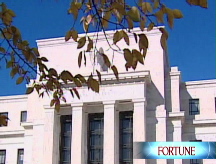Ex-AIG brass tries to shift blame
Problem wasn't in their judgment, they tell Congress, but in a bad accounting rule. Congress wasn't biting.
 |
| Willumstad, left, and Sullivan said market forces and accounting rules led to AIG's troubles. |
(Fortune) -- Two former CEOs of AIG tried to make the case at a Congressional hearing Tuesday that the downfall of the giant insurer and financial services firm wasn't their fault, but rather that of external forces, including an accounting rule.
Members of the House Committee on Oversight and Government Reform weren't buying it, not that lawmakers were necessarily well-versed in the rule in question, known as mark-to-market. But they seemed to know a half truth when they heard one.
Former chief executives Martin Sullivan, who resigned under pressure in June andRobert Willumstad, a former president of Citigroup who headed AIG until the government bailed out the company last month with an $85 billion loan, attributed the bulk of the insurer's problems to forces beyond their control.
Both men cited the unintended consequences of mark-to-market accounting, a practice that forced AIG to book unrealized losses on its book of mortgage-backed securities and credit default swaps - a type of contract which can insure everything from plain-vanilla corporate and municipal debt to esoteric products like collateralized debt obligations, or CDOs. AIG was a big player in both the default swap and mortgage-backed debt markets.
Sullivan said that when credit markets seized up, AIG was forced to mark its $70 billion in CDO swap positions at "fire-sale prices" even though it believed the positions would have much higher values if held to maturity.
"Suddenly, a company with a trillion dollars of assets was reporting unrealized losses on its income statement that ultimately climbed into the tens of billions," Sullivan said in his prepared statement.
Sullivan is correct in arguing that being forced to set aside large amounts of reserves for potential losses proved devastating. Eventually, AIG would face a downgrade in its credit rating, which would in turn force it to put up more collateral for its securities holdings and try to raise more capital than the private markets were willing to provide.
Sullivan isn't alone in arguing that mark-to-market has caused companies to unnecessarily report big losses on blocks of debt securities where the chance of actual defaults were low. Indeed the Securities and Exchange Commission is reexamining its stance on the rule.
But Sullivan and Willumstad's attempt to deflect blame raises a big question: How is it that the management of AIG, long one of the top 10 derivative trading houses globally, was not closely focused on the risk a ratings downgrade posed to its $500 billion credit default swap portfolio?
While the company was still enjoying a multi-billion dollar earnings stream, even as the credit crisis began to pick up steam in 2007, AIG's senior management (under Sullivan) essentially gambled that the securitized bond markets would rebound, and did nothing to lessen the company's potential exposure.
But the markets didn't respond as anticipated, and by September AIG was crippled and forced to accept government help at terms that basically wiped out shareholders. Willumstad's attempts to forestall that event by pursuing transactions with Berkshire Hathaway (BRKA, Fortune 500) and putting assets up for sale had come a year too late.
Rep. Mark Souder, an Indiana Republican, blasted the former CEOs for ducking responsibility for events that Souder said occurred under their watches. "How does an executive leave their company so vulnerable?" Souder asked. "You say it was a market tsunami as if you didn't cause it."
Lawmakers, citing AIG internal documents, also suggested that Sullivan and senior management failed to alert investors in a timely fashion about warnings from the company's outside auditors and others about problems brewing within the financial products unit, which oversaw the investments the would prove to be AIG's undoing. Sullivan disagreed.
"We supplied very, very fulsome disclosures," he said.
Lawmakers also took aim at AIG's board for agreeing to a hefty severance package for Sullivan and for waiving rules that would have tied his pay and that of other senior executives to losses in the financial products unit. With "these guys," said Rep. Chris Van Hollen, a Maryland Democrat, "there is absolutely no accountability." ![]()
-
 The retail giant tops the Fortune 500 for the second year in a row. Who else made the list? More
The retail giant tops the Fortune 500 for the second year in a row. Who else made the list? More -
 This group of companies is all about social networking to connect with their customers. More
This group of companies is all about social networking to connect with their customers. More -
 The fight over the cholesterol medication is keeping a generic version from hitting the market. More
The fight over the cholesterol medication is keeping a generic version from hitting the market. More -
 Bin Laden may be dead, but the terrorist group he led doesn't need his money. More
Bin Laden may be dead, but the terrorist group he led doesn't need his money. More -
 U.S. real estate might be a mess, but in other parts of the world, home prices are jumping. More
U.S. real estate might be a mess, but in other parts of the world, home prices are jumping. More -
 Libya's output is a fraction of global production, but it's crucial to the nation's economy. More
Libya's output is a fraction of global production, but it's crucial to the nation's economy. More -
 Once rates start to rise, things could get ugly fast for our neighbors to the north. More
Once rates start to rise, things could get ugly fast for our neighbors to the north. More








